Related Research Articles
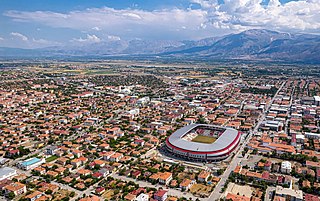
Erzincan, historically Yerznka, is the capital of Erzincan Province in eastern Turkey. Nearby cities include Erzurum, Sivas, Tunceli, Bingöl, Elazığ, Malatya, Gümüşhane, Bayburt, and Giresun. The city is majority Sunni Turkish with an Alevi Kurdish minority.

The Ağrı Province is a province in eastern Turkey, bordering Iran to the east, Kars to the north, Erzurum to the northwest, Muş and Bitlis to the southwest, Van to the south, and Iğdır to the northeast. Its area is 11,099 km2, and its population is 510,626 (2022). The provincial capital is Ağrı, situated on a 1,650 metres (5,410 ft) high plateau. Doğubayazıt was the capital of the province until 1946. The current governor is Mustafa Koç.

Bingöl Province is a province of Turkey. The province was known as Çapakçur Province before 1945 when it was renamed as Bingöl Province. Its area is 8,003 km2, and its population is 282,556 (2022). The province encompasses 11 municipalities, 325 villages and 693 hamlets.
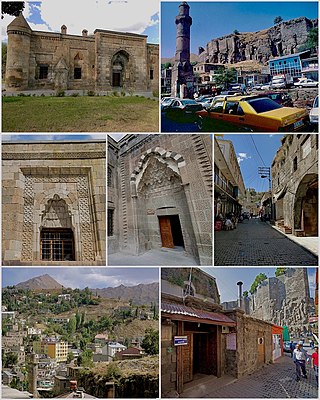
Bitlis is a city in southeastern Turkey. It is the seat of Bitlis District and Bitlis Province. Its population is 53,023 (2021). The city is located at an elevation of 1,545 metres, 15 km from Lake Van, in the steep-sided valley of the Bitlis River, a tributary of the Tigris. The local economy is mainly based on agricultural products which include fruits, grain and tobacco. Industry is fairly limited, and deals mainly with leatherworking, manufacture of tobacco products as well as weaving and dyeing of coarse cloth. Bitlis is connected to other urban centres by road, including Tatvan on Lake Van, 25 km to the northeast, and the cities of Muş (Mush), 100 km northwest, and Diyarbakır, 200 km to the west. The climate of Bitlis can be harsh, with long winters and heavy snowfalls. Since the local elections of March 2019, the Mayor of Bitlis is Nesrullah Tanğlay.

Islam began to make inroads into the Armenian Plateau during the seventh century. Arab, and later Kurdish, tribes began to settle in Armenia following the first Arab invasions and played a considerable role in the political and social history of Armenia. With the Seljuk invasions of the eleventh and twelfth centuries, the Turkic element eventually superseded that of the Arab and Kurdish. With the establishment of the Iranian Safavid dynasty, Afsharid dynasty, Zand Dynasty and Qajar dynasty, Armenia became an integral part of the Shia world, while still maintaining a relatively independent Christian identity. The pressures brought upon the imposition of foreign rule by a succession of Muslim states forced many lead Armenians in Anatolia and what is today Armenia to convert to Islam and assimilate into the Muslim community. Many Armenians were also forced to convert to Islam, on the penalty of death, during the years of the Armenian Genocide.
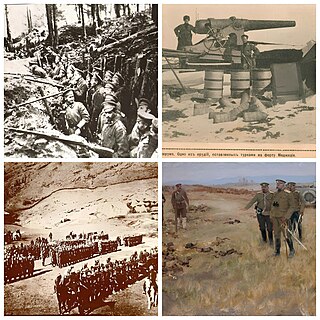
The Caucasus campaign comprised armed conflicts between the Russian Empire and the Ottoman Empire, later including Armenia, Azerbaijan, Georgia, the Mountainous Republic of the Northern Caucasus, the German Empire, the Central Caspian Dictatorship, and the British Empire, as part of the Middle Eastern theatre during World War I. The Caucasus campaign extended from the South Caucasus to the Armenian Highlands region, reaching as far as Trabzon, Bitlis, Mush and Van. The land warfare was accompanied by naval engagements in the Black Sea.

The Vilayet of Erzurum was a first-level administrative division (vilayet) of the Ottoman Empire.

The Vilayet of Van was a first-level administrative division (vilayet) of the Ottoman Empire. At the beginning of the 20th century, it reportedly had a population of about 400,000 and an area of 15,000 square miles (39,000 km2).

Bitlis Vilayet was a first-level administrative division (vilayet) of the Ottoman Empire. Before the Russo-Turkish War (1877–1878) it had been part of the Erzurum Vilayet, it was then made a separate vilayet by the Sublime Porte. It was one of the six Armenian vilayets of the Empire.
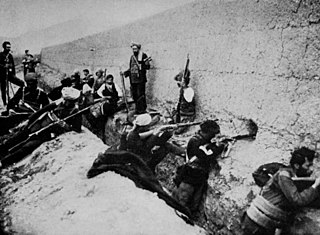
The defense of Van was the armed resistance of the Armenian population of Van against the Ottoman Empire's attempts to massacre the Ottoman Armenian population of the Van Vilayet in the 1915 Armenian genocide. Several contemporaneous observers and later historians have concluded that the Ottoman government deliberately instigated an armed Armenian resistance in the city and then used this insurgency as the main pretext to justify beginning the deportation and slaughter of Armenians throughout the empire. Witness reports agree that the Armenian posture at Van was defensive and an act of resistance to massacre. The self-defense action is frequently cited in Armenian genocide denial literature; it has become "the alpha and omega of the plea of 'military necessity'" to excuse the genocide and portray the persecution of Armenians as justified.
Justin A. McCarthy is an American demographer, former professor of history at the University of Louisville, in Louisville, Kentucky. He holds an honorary doctorate from Boğaziçi University (Turkey), was awarded the Order of Merit of Turkey, and is a board member of the Institute of Turkish Studies and the Center for Eurasian Studies (AVIM). His area of expertise is the history of the late Ottoman Empire.

Wilsonian Armenia was the unimplemented boundary configuration of the First Republic of Armenia in the Treaty of Sèvres, as drawn by U.S. President Woodrow Wilson's Department of State. The Treaty of Sèvres was a peace treaty that had been drafted and signed between the Western Allied Powers and the defeated government of the Ottoman Empire in August 1920, but it was never ratified and was subsequently superseded by the Treaty of Lausanne. The proposed boundaries of Wilsonian Armenia incorporated portions of the Ottoman vilayets of Erzurum, Bitlis, Van, and Trabzon, which had Armenian populations of varying sizes. The inclusion of portions of Trabzon Vilayet was intended to provide the First Republic of Armenia with an outlet to the Black Sea at the port of Trabzon. A proposed Republic of Pontus was discussed at the Paris Peace Conference of 1919, but the Greek government of Eleftherios Venizelos feared the precarious position of such a state, so a portion of it was instead included in the proposed state of Wilsonian Armenia.

The occupation of Western Armenia by the Russian Empire during World War I began in 1915 and was formally ended by the Treaty of Brest-Litovsk. It was sometimes referred to as the Republic of Van by Armenians. Aram Manukian of Armenian Revolutionary Federation was the de facto head until July 1915. It was briefly referred to as "Free Vaspurakan". After a setback beginning in August 1915, it was re-established in June 1916. The region was allocated to Russia by the Allies in April 1916 under the Sazonov–Paléologue Agreement.

The Battle of Bitlis refers to a series of engagements in the summer of 1916 for the town of Bitlis and to a lesser extent nearby Muş, between Russian Imperial forces and their Ottoman counterparts. The town was the last stronghold of the Ottoman Empire preventing the Russians from entering Anatolia and Mesopotamia.
The Harbord Commission was a U.S. commission tasked by President Wilson to study the relationship between the United States and Armenia following World War I. Major General James G. Harbord led the group and produced the final report which came to be called ‘The Harbord Report’.

The Six Vilayets, the Six Provinces, or the Six Armenian Vilayets were the main Armenian-populated vilayets ("provinces") of the Ottoman Empire. These were Van, Erzurum, Mamuret-ul-Aziz, Bitlis, Diyarbekir and Sivas.

The Vilayet of Sivas was a first-level administrative division (vilayet) of the Ottoman Empire, and was one of the Six Armenian vilayets. The vilayet was bordered by Erzurum Vilayet to the east, Mamuretülaziz Vilayet to the south-east, the Trebizond Vilayet to the north and Ankara Vilayet to the west.
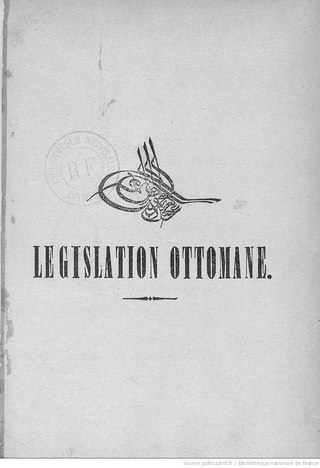
A vilayet, also known by various other names, was a first-order administrative division of the later Ottoman Empire. It was introduced in the Vilayet Law of 21 January 1867, part of the Tanzimat reform movement initiated by the Ottoman Reform Edict of 1856. The Danube Vilayet had been specially formed in 1864 as an experiment under the leading reformer Midhat Pasha. The Vilayet Law expanded its use, but it was not until 1884 that it was applied to all of the empire's provinces. Writing for the Encyclopaedia Britannica in 1911, Vincent Henry Penalver Caillard claimed that the reform had intended to provide the provinces with greater amounts of local self-government but in fact had the effect of centralizing more power with the sultan and local Muslims at the expense of other communities.

Grace H. Knapp was an American Christian missionary and teacher who served in the Ottoman Empire. During her time as a missionary, Knapp was a witness to the Armenian genocide. During the Armenian genocide, Knapp was stationed in Van and eventually described the events in the region in two published books describing her experiences. The first book, The Mission at Van in Turkey in War Time, describes in detail the massacres of Armenians by Turkish soldiers during the Van Resistance. Her second book, The Tragedy of Bitlis, relates the narratives of two nurses who witnessed massacres of Armenians in Bitlis. Her recounts of Bitlis are one of the few written accounts of massacres in that area.

During World War I, several Kurdish rebellions took place within the Ottoman Empire.
References
- ↑ U.S. National Archives, 184.021/175
- ↑ Captain Niles would later become Chief Judge of the Supreme Bench of Baltimore City and likely deserves his own Wiki page, but until then, refer to the Maryland archives site for his biography: https://msa.maryland.gov/megafile/msa/speccol/sc3500/sc3520/013500/013505/html/13505bio.html | accessed January 29, 2024
- ↑ "Niles and Sutherland Report", Justin McCarthy, Kongreye Sunulan Bildiriler: X1. Turk Tarih Kongresi, Ankara, 1990, pp. 1809-1853
- ↑ Harbord, James G., Report of the American Military Mission to Armenia, (Government Printing Office, 1920), 3.
- ↑ "All of the vilayets (provinces) of Turkish Armenia were visited except Van and Bitlis, which were inaccessible in the time available, but which have been covered by Captain Niles, an army officer who inspected them on horseback in August, and whose report corroborates the observations in the neighboring regions.35 (Footnote: Harbord in 184,02102/5, p. 2.)
- ↑ Harbord, James G., Report of the American Military Mission to Armenia, (Government Printing Office, 1920), 8.
- ↑ Ussher, Clarence D. (1917). An American Physician in Turkey. Houghton Mifflin Company.
- ↑ Nogales, Rafael de. Memoirs Of A Soldier Of Fortune . Bradstreet Press, 1932, p. 270. "Our ferocious onslaught and our heavy artillery fire had turned two-thirds of Van into a smouldering, fiery shambles...", p. 272; "As soon as a building fell into our hands it was immediately set afire, to prevent the enemy from trying to recover it during the night.", 274; "Twelve hours after my departure, Djevded had twenty-seven shells fired into the American mission buildings, demolishing them...".
- ↑ Justin McCarthy et.al. Armenian Rebellion At Van. University of Utah Press, 2006, pp. 233-257.
- ↑ Justin McCarthy et al. The Armenian Rebellion At Van. University of Utah Press, 2006, pp. 1-2.
- ↑ Justin McCarthy et al. The Armenian Rebellion At Van. University of Utah Press, 2006, p. 2.
- ↑ "Washington University Course: Niles & Sutherland Archive".
- ↑ Arthur E Sutherland's granddaughter Anora. "About the Niles and Sutherland Report".
- ↑ Online evidence of this will be available later in 2024, and will be added here as a qualified reference.